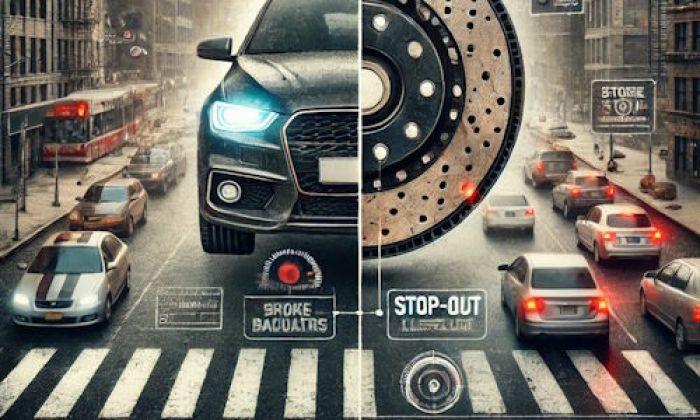Electronic Stability Control (ESC) in your Silverado is the set of sensors and units working together to provide you with total control over your truck. If the vehicle loses traction and stability on the road, the computer commands brakes and throttle flap to work together to avoid skidding and other unpleasant situations. But what if you see a "Service ESC" error message in your Chevy Silverado?
Service ESC message highlights
- Common reasons:a ton of reasons including ABS sensors, steering wheel angle sensor, throttle, etc.
- How to fix:read the codes in all control modules to make the conclusion
- Possible consequences:stability of the car may be affected, safety may be affected
- Priority level:Medium
- Can you drive?Carefully
- DIY repair:Possible but complicated
- Repair price range:$150-$800

"Service ESC" in the Silverado - what's this?
There are two main reasons why the "Service ESC" error message may pop up on the dash of your Chevy Silverado:
- the ESC system is active and is trying to stabilize your car;
- the ESC is malfunctioning and showing you that it needs some repairs.
If it's the first option, you shouldn't worry at all. Sometimes, the Service ESC message may appear together with the ESC warning light on the dash when the system is active. It's working to stabilize your car on the road, avoid skidding, etc. Although it shouldn't show you any error messages, such events have been registered in the Silverado and other Chevy models. Usually, the ESC warning light blinks when this happens.
If it's about a problem in your ESC system, things are much worse. If you see this message and warning light when the car is going on a good road and doesn't lose its stability, the ECU detected some problems with the components of the Electronic Stability Control. The system uses dozens of different sensors and units, so it's not that easy to tell you right now what exactly malfunctions.
Usually, you will experience these symptoms in your truck:
- the "Service ESC" error message will pop up on the dash:
- the warning light showing the car with two wavy lines will light up on the dashboard;
- the ESC will be automatically deactivated, and your car may go to the skid, especially on slippery roads;
- there will be one or several error codes in the ECU;
- some other functions of your car may stop working;
- but this shouldn't stop you from driving the truck, you will just need to be more careful.
While a lot of drivers think that they don't use the ESC system, they actually do, and quite a lot. It means that the system is working secretly and stabilizes the car whenever needed without showing this or asking for your approval. This is the safety system that is always active unless deactivated by the button temporarily.
Common reasons for ESC problems in the Silverado
I won't be able to list all the possible problems that affect the work of the ESC system in your truck. This would take me several days to write and then it would take you several days to read. Instead, I will write about the most common reasons that may cause this error message to pop up and eventually make you worry.
So, for the Silverado, these are the common problems:
1. Software error for ESC and ABS
First of all, you should check if your Silverado is not on the list of recalled trucks by GM. There was a recall because of the software glitch and they recalled about half a million vehicles of different models including the Silverado 1500.
It's important to regularly check if your truck is under a recall. Fixing the problem that is in the recall is crucial for safe and comfortable driving. Otherwise, you may just get into trouble one day. So, contact your dealer and ask if your VIN has some recalls on it.
2. Lots of snow in the wheel hubs
It's hard to say why but when snow builds up in the hub, it can interfere with some sensors like wheel speed sensor or maybe some ABS unit. That's why when you are driving in deep snow, you may see the "Service ESC" error message. It will then disappear when the snow and ice melt off your vehicle.
It's not a great idea to go to the dealership once you experience this. It's not a serious problem, just some special peculiarity of your truck to remember about. Let the snow melt off and you will get all the safety functions back.
3. Wheel speed sensor problems
The ESC system has to know the speed of rotation of every wheel. This is what it shares with the ABS system. But the wheel speed sensors are certainly not the most reliable parts of your Silverado. It's obvious that you need to check them from time to time and make sure they work well.
They may not seem a really important part of the truck. But actually, the wheel speed sensors work with several vital safety systems and may completely block their functions. It means that if you spot a problem with wheel speed sensors, you better replace the broken unit as soon as possible.
4. Wiring issues
It's not uncommon for a Silverado to develop wiring problems. You may drive your truck in harsh terrains and some stone, piece of wood, or any other thing on your way may affect the wiring in the undercarriage. Some wires may connect the wheel sensors with the ECU and ESC modules, for example.
Overall, wiring and connections are not the strongest factors in Chevy trucks. The connections may get corroded after any contact with water. This is another common issue you should know about. Very often, the "Service ESC" error message pops up after you drive in deep puddles or across small rivers when off-roading.
5. Steering angle sensor
This is another crucial part of the ESC. In order to make proper decisions about the stability of the car on the road, the ESC module needs to know for sure the position of the steering wheel. The steering angle sensor is there to help it and give the required information.
This is one of the obvious things you should check if the "Service ESC" message pops up on the dash of your Silverado.
6. Brake pedal switch
Another pretty common problem, especially on high-mileage trucks, is the brake pedal switch. If the ESC system doesn't know when you press the brake pedal, it just can't assist you in stabilizing the truck. For this, Chevy introduced the brake switch. It activates the brake lights and also sends the information to the ECU, ABS, and ESC modules.
Replacing the switch is pretty easy. You may check this unit just by pressing the brake pedal and asking someone to see if the brake lights illuminate at the rear end of the car.
Your actions when you see the "Service ESC" message
Since ESC is the safety system in your vehicle, you should know that it's important to keep it in good condition at all times. So, if you see the error message and warning light telling you that the ESC is not working, you shouldn't ignore this.
Here's what you need to do:
- you can continue driving, but you should be extremely careful on the road;
- avoid driving on slippery roads at high speed if ESC malfunctions;
- as soon as possible, visit a dealership or a trusted shop to have the problem inspected;
- you may also want to check several common possible problems on your own;
- make sure that the ESC system is not deactivated manually in your Silverado;
- read the codes if you have an OBD2 scanner - this will give you more info about the problem.
If you read the codes and see that the ECU stores the error codes for wheel speed sensors, you don't need any inspection - you've just found the problem. But very often, the codes just hide when the system works well, so it's quite challenging to locate the initial problem that triggers this error message.
I recommend you go to the dealership and have the vehicle inspected by professionals. This will cost you some money but you will know for sure what exactly causes the problem.
Final thoughts
Although the ESC problems are very serious and need proper attention, you can drive your truck with the "Service ESC" message on the dash. It doesn't mean that you can ignore the problem for months till you have time or money to go to the shop. It's important to keep the ESC system working because this is one of the important safety features in your car.
Also, when ESC malfunctions, there is always a chance that the problem is with the brakes. So when you continue driving, be very careful and never accelerate to high speeds in this condition.
About the authors
The CarAraC research team is composed of seasoned auto mechanics and automotive industry professionals, including individuals with advanced degrees and certifications in their field. Our team members boast prestigious credentials, reflecting their extensive knowledge and skills. These qualifications include: IMI: Institute of the Motor Industry, ASE-Certified Master Automobile Technicians; Coventry University, Graduate of MA in Automotive Journalism; Politecnico di Torino, Italy, MS Automotive Engineering; Ss. Cyril and Methodius University in Skopje, Mechanical University in Skopje; TOC Automotive College; DHA Suffa University, Department of Mechanical Engineering






Add comment